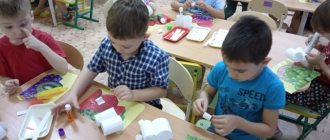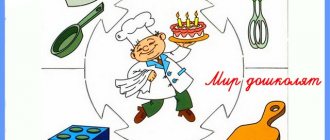Construction in an early age group
| Spring. Transformations, revitalization, awakening of nature. | |||||||||||||||
| 17 | 14.05 | Spring | Sand construction | Reinforce knowledge about the properties of sand. Learn to build a tower, a dog house, paths, benches, tables, etc. Develop thinking, memory, and creativity. Cultivate an interest in sand construction. | Sandbox | Cognitive development (formation of a holistic picture of the world, expansion of horizons, development of research activities, femp), speech development, hair (literary art), skr (s\r\i), physical | I.A.Lykova Design in kindergarten p.18 | ||||||||
| 18 | 28.05 | Flowers | Fences high and low | Teach: change the building in height; name the details: bricks, cubes; build a variety of fences, different in height. Strengthen the ability to arrange parts. Develop a sense of shape and color, an interest in flowers. To cultivate the ability to see the beauty of nature, understand its fragility, and evoke a desire to protect it. | Construction sets, decorative flowers on stands | Cognitive development (formation of a holistic picture of the world, broadening one’s horizons, development of cognitive and research activities, femp), hair (literary arts), physical development | I.A.Lykova Construction in kindergarten p.17 | ||||||||
Pedagogical monitoring is carried out in order to determine the dynamics of the child’s current individual development profile and is used to solve the following problems: • individualization of education (including supporting the child, building his educational trajectory or professional correction of his developmental characteristics); • optimization of work with a group of children. Pedagogical monitoring is based on the principles of supporting the specificity and diversity of childhood, as well as the uniqueness and intrinsic value of childhood as an important stage in the overall development of a person. In this regard, pedagogical monitoring: - does not contain any assessments of the child’s development related to recording educational achievements; — allows you to record the current individual development profile of a preschooler and evaluate its dynamics; — takes into account the child’s zone of proximal development in each direction; — allows us to consider the entire period of a child’s development from birth to school as a single process without conditional division into different age stages “tied” to the passport age, while taking into account age-related patterns of development, based on an assessment of changes in the activity of a preschooler; — takes into account the targets presented in the Program, but does not use them as the basis for their formal comparison with the actual achievements of children. Tools for pedagogical monitoring of child development - observation cards and an electronic application that will allow teachers to analyze the dynamics of child development. Where calculations are carried out using a certain formula. The results obtained are expressed as percentages and determine the so-called success rate of each child. At the beginning of the school year, based on the results of monitoring, the zone of educational needs of each student is determined: a high level corresponds to a zone of increased educational needs, a medium level corresponds to a zone of basic educational needs, and a low and low level corresponds to a risk zone. Accordingly, planning of the educational process is carried out based on the integration of educational areas, taking into account individualization. At the end of the school year, conclusions are drawn about the degree to which the educational needs of children are met and about the achievement of positive dynamics in the educational needs themselves. Principles of assessment - three-level monitoring system - 2 points “quality manifests itself sustainably”, 1 point “quality manifests itself unsustainably”, i.e. is in the zone of proximal development and is manifested only in joint activities with an adult, 0 point - “quality is not manifested.” In some cases (if necessary), psychological diagnostics of children can be carried out. It is carried out by qualified specialists (for example, educational psychologists) and only with the consent of the parents (legal representatives) of the children. The information obtained during monitoring is the basis for predicting activity, making the necessary correction, and a tool for notifying parents about the condition and problems identified in the child. Diagnostic card: Type of activity: Construction
SECTION 2. WHAT A BABY FROM 1 TO 3 YEARS CAN BUILD FROM CONSTRUCTION TOYS
At an early age, the baby learns from his mother not only the names of parts, but also how to operate with them - elementary methods of construction. Let's get acquainted with these design methods for the little ones, I give them in order with a gradual complication of the tasks:
Method 1. Place the construction parts horizontally and vertically and see that this changes their stability.
For example:
- The cubes can be placed horizontally to create train carriages. Or you can put it vertically - make a turret.
- The bricks can lie horizontally on the table, and then we will have a path. It may be different. You can make a narrow path if you connect the bricks with the narrow side. Or you can use a wide path if you connect them to each other with their long side.
- If you place the same bricks vertically on a table next to each other, you will no longer get a path, but a fence!
- If you place a brick vertically next to the cube, you get a chair. And if you put the same brick horizontally on the same cube, you will get a completely different building - not a chair, but a table!
Method 2. Lay the parts one on top of the other, make overlaps. This is how we get houses and gates.
Method 3. Close the parts into one ring, forming a closed space.
Examples:
- Example 1. From bricks placed on edge, we build a fence for chickens, cows, make a park, make a yard for walking nesting dolls and other small figures of people and animals.
- Example 2. We can also build a garage for a toy car, into which it will drive through a gate.
- Example 3. You can even take a tram or bus with your child. To do this, we build a closed space from bricks, and after that we place seats for passengers and a place for the driver in it. We can move one of the bricks to the side when passengers enter the cabin. This will be the door. You can come up with many options for “arranging” such a bus.
Our main task is for the child not just to repeat after us some new method of action, but to begin to use it in his own independent games. Therefore, we vary the games and show one way of design using the example of different buildings and different game plots.
Constructor “Animals” (Ozon, My-shop)
A very good designer, it has been our “hit” for a long time. The constructor includes many options for paws, heads, torsos, and tails, allowing you to assemble a wide variety of animals. You can collect both animals in their classic form and funny hybrids. This is the only way fantasy develops. And at the same time, the idea of animals and their body parts is consolidated.
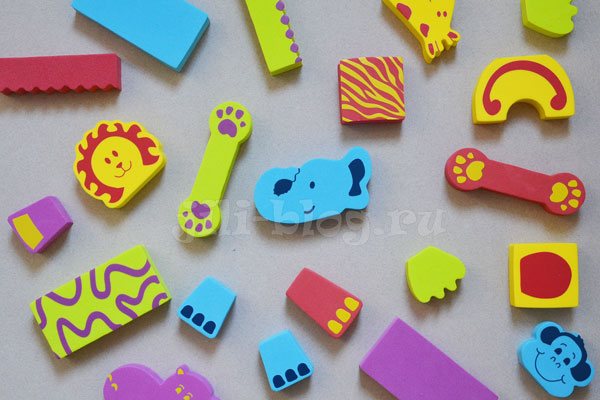
We have a “beast constructor” from Edushape, it is made of soft foam material, somewhat similar to polystyrene foam, the parts are not connected to each other in any way. Perhaps this will seem like a minus to some, but on the contrary, I really liked the fact that while assembling it, my daughter learned to find balance, tried to place the parts carefully so that they would not fall.
Here is an example of a similar wooden construction set from Djeco.
Lego also has a similar animal constructor: Ozon, My-shop, MyToys.
Constructor “Zolo” (Ozon, My-shop)
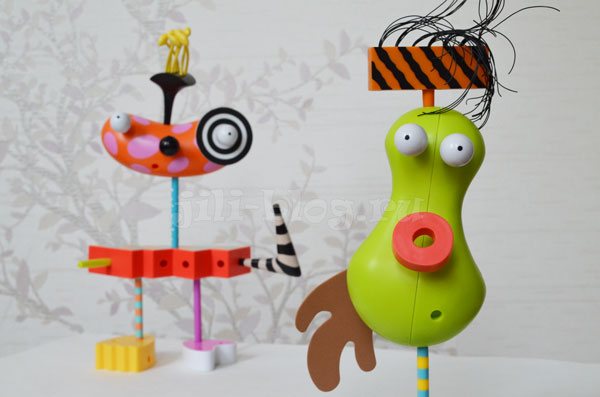
A completely unusual construction set with oddly shaped parts and a non-standard principle of connecting parts. Such a construction set is not needed at all to build houses or fences; this construction set is needed to excite children’s imagination and create unusual shapes. You can build the most incredible creatures from it (perhaps yours will be weirdos or aliens). The creation process is very exciting, you can laugh heartily, giving free rein to your imagination. Well, when the creatures of alien origin are ready, you can come up with funny names for them like five-legged, big-eyed or bubuzyaki.
I think the most valuable thing about this construction set is that it helps a child learn to think outside the box: after all, it is absolutely not necessary for an unknown alien to have two eyes and two legs, and why does he need a torso at all and why does his nose have to be on his head? In general, we fantasize. Perhaps someone will consider this designer crazy, but it is my favorite.
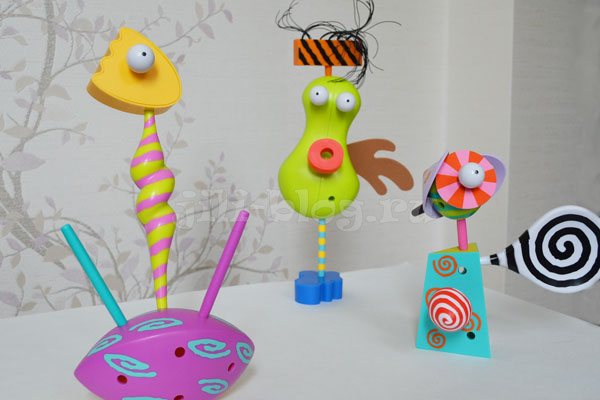
I really hope that the Zolo construction set will appear in stores again, because it simply has no analogues. The Ogobild construction kit is somewhat similar to it, but with it, it seems to me, it’s better to fantasize about inanimate, technical topics. And it is much more difficult to fasten parts in Ogobild, so it is more suitable for children after 3-4 years.
3. Road (Ozon, My-shop, MyToys)
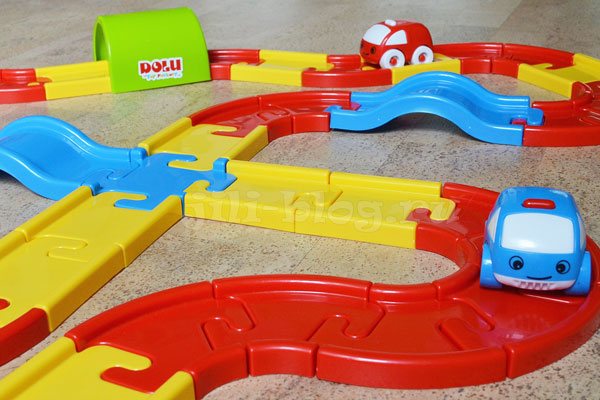
There is an opinion that girls always play with dolls, and boys with cars, maybe this is partly true, but it definitely doesn’t apply to road constructors. When my daughter was given a road at the age of 2, she was so captivated by it that for about two months, every day in the morning on the floor of the nursery we were greeted by a new shaped highway. I must say that Tasya liked the construction process; sometimes he didn’t even get to the point of rolling cars. I think boys will find any construction set in the form of a car or railroad even more interesting.
For the little ones, it is very important to choose a road construction set so that the parts interlock without unnecessary effort, and the child can assemble the road himself, without the help of an adult. We played with a car construction kit from a little-known company called Dolu. I couldn’t find it for sale, so I’m giving links to the Brio railway (Ozon, My-shop, MyToys) and its analogues (Ozon, My-shop, Read).
SECTION 5. DESIGN FOR CHILDREN FROM ONE AND A HALF TO 2 YEARS OLD
INTRODUCTION TO CONSTRUCTION PARTS AND THEIR NAMES, COLOR, SHAPE, SIZE
At this age, great changes occur in the baby’s mental development. As a result, if earlier he could only fulfill the request “give me the same as mine,” then by 1 year 9 months - 2 years he can fulfill the more complex request “Give me the same brick, but red,” i.e. can identify 2 characteristics of an object at the same time. This does not come immediately, but gradually, as a result of the baby becoming familiar with the shape of the parts, their color and size.
We can offer the child tasks with construction set parts, such as “Find the blue bricks. Where is the big brick? Where is the small brick (we call the size and shape - 2 signs at the same time)?”, “Find the yellow hats - large and small” (the shape of the part, its color and size are called simultaneously).
The baby can already distinguish the size of parts well, and therefore we can teach him to compare and find three parts of the same shape, but of different sizes: “big cube” - “smaller” - “small cube”.
At our request, the baby will give a large cube to a large toy, and a small cube to a small toy.
From 3-4 pieces of different shapes, the child will choose and give, at the request of an adult, a cube, a roof, a column, a brick: “Give me a roof. Where is our brick? Give it to me, please.”
Of course, this is only possible if an adult names these parts while playing with the construction set and introduces the child to them.
PLAYING WITH THE CONSTRUCTOR
Very often, children from one and a half to two years old repeat the same action many times in a row. They enjoy it, as if they are convincing themselves: “I can already do this!” After all, the main thing for a child is not the result, but the process; if he repeats it, it means he gets great pleasure from it! Do not disturb the baby, let him repeat, he really needs this for his development. The time will come - and he himself will move from the old, learned, to the new.
At this age, the baby will not be able to build the building himself. Therefore, it is not the child, but the adult who starts the game with the constructor and leads it. At this age, we build one building at a time. For example, just a house. Or just a bench.
Mom plays out a game story with toys - for example, she builds a path out of bricks for a matryoshka doll, along which the matryoshka will run to her house: stomp, stomp, stomp, stomp, stomp. The baby joins in the construction, repeats his mother’s actions - helps build a path for the nesting doll, imitates his mother. Now the path is ready. The child can pick up the nesting doll and show how it walks along the path.
I will give an example of one of the first games with a construction set for children of the second year of life. Author – S. L. Novoselova.
For the game you will need: a chicken figurine, a chicken figurine (or one toy chicken, the size of the cubes and the chicken), 8 identical cubes.
Helpful advice: It is very important that the cubes that we give the child for this game are familiar to him. Otherwise, he will examine them instead of listening to the story, and he will not build a tower for the chicken.
Progress of the game situation:
— An adult shows the children a toy – a chicken. And he acts out a scene. The hen has lost her chicks and can’t find them.
— An adult invites the child to help the chicken and builds a tower of 4 cubes, placing them one on top of the other. The chicken flies up to the built turret, sees her chickens from it, and is very happy: “Chickens have been found!” (the adult, unnoticed by the child, places a figurine of chickens on the table).
- The chicken jumps from the turret and runs to the chickens (we put the chicken figurine in our pocket unnoticed by the child, the turret remains on the table).
-Where is the chicken? The chickens are alarmed, don’t see her, and are lost again! They write “pee-pee-pee” and look for mom. We need to build turrets for them, let them fly up on them and see their mother.
— The child is given 4 cubes. A child builds a turret, the chickens fly up to it and see their mother! How they rejoice! (we take out a chicken figurine). And here comes the chicken! The chickens found their mother!
The next time, to consolidate, you can repeat the construction of the turret, but always with a different plot. For us it will be a repetition, but for the child it will be a completely new story!
WHAT BUILDINGS CAN BE BUILD WITH A BABY FROM ONE AND A HALF TO TWO YEARS OLD
By the age of two, the child will already be able to build the simple buildings he knows on his own.
Building options: path, bench, ladder of 6 cubes (the first step is one cube, the second step is two cubes and the third step is three cubes), a fence, a gate, a slide, a tower and other very simple and very quickly realized buildings from parts of two shapes (cubes and bricks).
For example:
- turret (put cube on cube,
- house (prism - “roof” is placed on the cube),
- machine (we place the cube and brick on the plate),
- brick path
- table (put the brick flat on the cube),
- chair (we place a brick on the back of the cube - “the back of the chair”),
- bench (we place a plank or brick on two cubes),
- gate (we place the bricks vertically and place a bar on them).
Lego Duplo and its analogues (Ozon, My-shop)
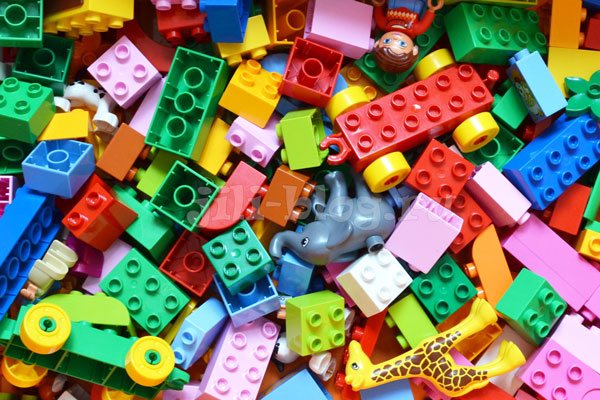
Lego needs no introduction; it is a constructor that has been tested by time and millions of children around the world. From the age of 2, a child will be interested in building paths, fences, houses, collars, chairs, tables, as well as some simple decorations that may be needed for role-playing games. It must be said that the animals and people included in Lego sets greatly increase a child’s interest in the game and motivate them to build this or that building. For example, one of our favorite buildings is an animal zoo. First we build fences, then we organize a game with the sale of tickets and visits to animals.
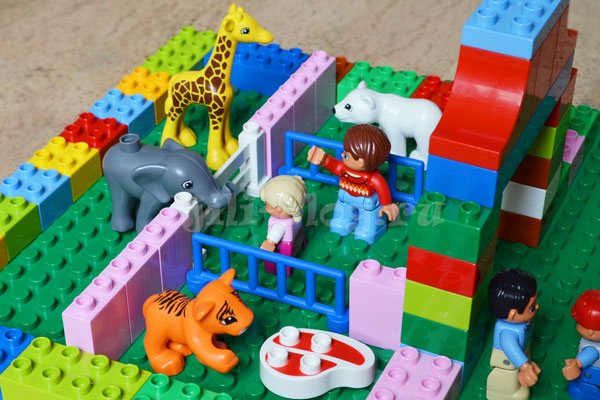
True, when buying a role-playing set with animals and other figures, you need to be more careful. Very often, sets are made in such a way that they limit the child’s imagination to only one version of the game, and also contain ready-made elements that can be used in one single way. Thus, the presence of ready-made roofs, walls, tables, chairs in the set deprives the child of the opportunity to dream up and figure out how to make the same thing from a construction set himself. Therefore, try to buy construction sets that contain many universal elements and as few ready-made solutions as possible.
If you want a construction set with even larger parts than Lego Duplo, then you can choose, for example, the Mega Blocks construction set (Ozon, MyToys). But generally speaking, all Lego analogues are noticeably inferior to the original in terms of precision of parts and quality of plastic.
